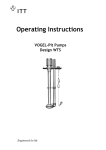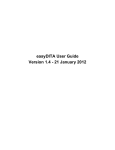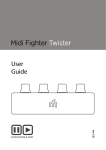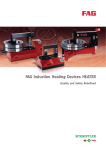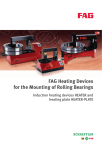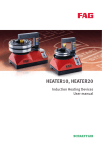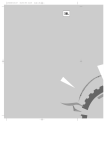Download Operating Instructions
Transcript
Operating Instructions Type: VOGEL Order no.: EC-Manufacturers Declaration (only valid for pump) acc. to Machine Directive 2006/42/EG Appendix II B of European Parliament and Council of 17.05.2006. Manufacturer: ITT Austria GmbH A-2000 Stockerau, Ernst Vogel-Straße 2 Products: Pumps of model WT 1) 1) The mentioned products are intended for Installation into a machine / Assembly with other machines . Their putting into operation is forbidden so long, till it is proven, that the machine, in which the pump shall be integrated, corresponds with the regulations of the Machine Directive 2006/42/EG. Used harmonised norms, especially EN 809 EN ISO 12100 part 1 EN ISO 12100 part 2 Used national technical norms and specifications, especially DIN 31001 The Declaration of the Manufacturer expires, when the pump is installed into units, where no declaration of conformity, acc. to the Machine Directive 2006/42/EG, is existing. Stockerau, 25.05.2009 1) ................................................................................................ Robert Salzbauer Quality control Strike out what´s not the case EC-Declaration of Conformity on customer buyouts If essential components of the unit (e.g. motors) are provided by the customer and only the assembly of these components is made by ITT Austria, the whole conformity must be proved by the customer! EC- Declaration of Conformity (only valid for units completely delivered by ITT Austria) acc. to Machine Directive 2006/42/EG Appendix II A of European Parliament and Council of 17.05.2006. Manufacturer: ITT Austria GmbH A-2000 Stockerau, Ernst Vogel-Straße 2 Products: Pumps of model WT The mentioned products correspond with the regulations of the EC-Machine Directive 2006/42/EG. Used harmonised norms, especially EN 809 EN ISO 12100 part 1 EN ISO 12100 part 2 EN 60204 part 1 Used national technical norms and specifications, especially DIN 31001 For Declaration of Conformity of appliances and / or components (e.g. motors) used with the unit, refer to attachments. The Declaration of Conformity expires, when the pump is installed into units, where no Declaration of Conformity, acc. to Machine Directive 2006/42/EG, is existing. Stockerau, 25.05.2009 ................................................................................................ Robert Salzbauer Quality control Operating instructions Table of Contents Data Sheet 1. General ............................................................................................ page 3 1.1 Foreword 1.2 Guarantee 1.3 Safety regulations 1.4 Safety instructions Dangers of not following safety instructions Safety instructions for the operator Speed, Pressure, Temperature NPSH Sealing, Flushing, Cooling, Minimum flows Protection against running dry Back flow 2. Description ...................................................................................... page 7 2.1 Model 2.2 Shaft Sealing 2.3 Bearings and Lubrication 3. Transport, Handling, Storage ....................................................... page 7 3.1 Transport, Handling 3.2 Storage 4. Installation, Operation ................................................................... page 9 4.1 Preparing for installation 4.2 Assembly and installation the pump 4.3 Installation and Alignement of Coupling Permitted displacement for flexible couplings 4.4 Connecting the pipes to the pump Discharge pipe Auxiliary pipes 4.5 Electrical connection 4.6 Starting up Starting up for the firts time Restarting 4.7 Operation and Monitoring Permitted number of starts 4.8 Shutting down 4.9 Dismantling 5. Maintenance, Servicing .................................................................. page 13 Stuffing boxes Mechanical seals Oil lubrication Couplings Cleaning the pump WT 101/3 1 Operating instructions 6. Longer periods of non-operation .................................................. page 15 6.1 Drained pumps 6.2 Filled pumps 7. Faults - Causes and Solutions ........................................................ page 16 8. Repairs ............................................................................................. page 19 9. Spare parts, spare pumps .............................................................. page 19 9.1 Spare parts Ordering spare parts 9.2 Stand-by pumps 10. Plant Manager List ....................................................................... page 20 11. Log Book ........................................................................................ page 21 Appendix WT 101/3 2 Operating instructions 1. General 1.1 Foreword This product complies with the safety requirements of EC Machinery Directive 2006/42/EC. The staff employed on installation, operation, inspection and maintenance must be able to prove that they know about the relevant accident prevention regulations and that they are suitably qualified for this work. If staff do not have the relevant knowledge, they should be provided with suitable instruction. The operating safety of the pumps or units (i.e. pump plus motor) supplied is only guaranteed if these are used in accordance with the provisions given in the attached Data Sheet and/or Point 4 in „Installation and Operation“. The operator is responsible for following the instructions and complying with the safety requirements given in these Operating instructions. Smooth operation of the pump or pump unit can only be achieved if installation and maintenance are carried out carefully in accordance with the rules generally applied in the field of engineering and electrical engineering. If not all the information can be found in these Operating instructions, please contact us. The manufacturer takes no responsibility for the pump or pump unit if the Operating instructions are not followed. These Operating instructions should be kept in a safe place for future use. If this pump or pump unit is handed on to any third party, it is essential that these Operating instructions and the operating conditions and working limits given in the Confirmation of Order are also passed on in full. These Operating instructions do not take into account all design details and variants nor all the possible chance occurrences and events which might happen during installation, operation and maintenance. Alterations or changes to the machine are only permitted by agreement with the manufacturer. Original spare parts and accessories authorised by the manufacturer should be used for greater safety. We bear no responsibility for the consequences of using other parts. We retain all copyright in these Operating instructions; they are intended only for personal use by the owner of the pump or the pump unit. The Operating instructions contain technical instructions and drawings which may not, as a whole or in part, be reproduced, distributed or used in any unauthorised way for competitive purposes or passed on to others. 1.2 Guarantee The guarantee is given in accordance with our Conditions of Delivery and/or the confirmation of order. Repair work during the guarantee period may only be carried out by us, or subject to our written approval. Otherwise the guarantee ceases to apply. Longer-term guarantees basically only cover correct handling and use of the specified material. The guarantee shall not cover natural wear and tear and all parts subject to wear, such as impellers, shaft sealings, shafts, shaft sleeves, bearings, wear rings etc., or damage caused by transport or improper handling. WT 101/3 3 Operating instructions In order for the guarantee to apply, it is essential that the pump or pump unit is used in accordance with the operating conditions given on the type plate, confirmation of order and in the Data Sheet. This applies particularly for the endurance of the materials and smooth running of the pump and shaft sealing. If one or more aspects of the actual operating conditions are different, we should be asked to confirm in writing that the pump is suitable. 1.3 Safety regulations These Operating instructions contain important instructions which must be followed when the pump is assembled and commissioned and during operating and maintenance. For this reason, these Operating instructions must be read by the skilled staff responsible and/or by the operator of the plant before it is installed and commissioned, and they must be left permanently ready to hand at the place where the pump or pump unit is in use. The operator must ensure that the contents of the Operating instructions are fully understood by the staff. The operator must confirm this by signing the „Plant Manager List“ (see Point 10). These Operating instructions do not refer to the General Regulations on Accident Prevention or local safety and/or operating regulations. The operator is responsible for complying with these (if necessary by calling in additional installation staff). The safety instructions contained in these Operating instructions have the following special safety markings as specified in DIN 4844: Warning against personal accidents which could occur if the safety instructions given in this part of the Operating instructions are not followed. Warning against dangerous electrical voltage. Please note Warning against possible damage to property or the environment. It is absolutely essential that safety information affixed directly to the pump or pump unit is followed and maintained so that it is always easily legible. 1.4 Safety instructions Dangers of not following safety instructions Failure to follow the safety instructions can result in the following, for example: • People being at risk because of electrical, mechanical and chemical factors. • Important functions of the pump or pump unit failing. • Dangers to the environment as a result of dangerous substances leaking out. WT 101/3 4 Operating instructions Safety instructions for the operator • Depending on the operating conditions, wear and tear, corrosion or age will limit the working life of the pump/pump unit, and its specified characteristics. The operator must ensure that regular inspection and maintenance are carried out so that all parts are replaced in good time which would otherwise endanger the safe operation of the system. If abnormal operation or any damage are observed, the pump must cease operation immediately. • If the breakdown or failure of any system or unit could lead to people being hurt or property being damaged, such system or unit must be provided with alarm devices and/or spare modules, and they should be tested regularly to ensure that they function properly. • If there is any risk of injury from hot or cold machine parts, these parts must be protected against contact by the user, or suitable warning signs must be affixed. • Contact protection on moving parts (e.g. coupling guards) must not be removed from systems that are in operation. • If dangerous media (e.g. explosive, toxic, hot) leak out (e.g. from shaft seals), these must be directed away so that there is no danger to people or the environment. The provisions of the law must be observed. • Measures should be taken to exclude any danger from electricity (e.g. by complying with the local regulations on electrical equipment). If work is carried out on live electrical components, they should be unplugged from the mains or the main switch turned off and fuse unscrewed. A motor protection switch is to be provided. • Basically, all work on the pump or pump unit should only be carried out when the pump is stationary and not under pressure. All parts must be allowed to return to ambient temperature. Make sure that no-one can start the motor during such work. It is essential that the procedure for stopping the system described in the Operating instructions is observed. Pumps or pump systems that carry media that are dangerous to health must be decontaminated before being taken apart. Safety Data Sheets for the various liquids handled. Immediately the work has been completed, all safety and protective devices must be replaced or restarted. • Under EC Machinery Directives, every machine must be fitted with one or more emergency command devices by which situations which represent an immediate danger or which could later be dangerous can be avoided. This does not include machines in which the emergency switches cannot reduce the danger, either because they do not reduce the time required to stop the machine or because the do not allow the measures required by the danger to be taken. This emergency switch must: have controls that are clearly marked, easy to see and within easy reach; stop the dangerous movement as quickly as possible without causing any additional danger; trigger any specified safety movements or allow these to be started up. If the emergency command device is no longer operated after an emergency „off“ switch has been triggered, this must be maintained by blocking the emergency command device until it is released again. It should not be possible to block the device without this triggering an emergency „off“ switch. It should only be possible to release the device through an appropriate action; this release should not start the machine up again - it should only make it possible to start it up again. • If the power supply is interrupted or restored after being interrupted or if it is changed in any other way, this should not cause any danger (e.g. pressure surges). WT 101/3 5 Operating instructions Speed, Pressure, Temperature Suitable safety measures must be taken at the plant to ensure that the speed, pressure and temperature of the pump and the shaft sealing do not exceed the limit values given in the Data Sheet. The given admission pressures (system pressures) must also be sufficiently high. In addition, the pump must be protected against pressure surges such as can be caused by switching off the plant quickly (e.g. by non-return valve on the pressure side, flywheel, air vessel). NPSH When entering the impeller, the liquid being handled must have a minimum pressure NPSH to prevent cavitation or breaking off of flow. This requirement is met if the unit NPSH value (NPSHA) is well above the pump NPSH value (NPSHR) under all operating conditions. Attention must be paid to the NPSH value in particular when liquids close to boiling point are being handled. If the value falls below the pump NPSH value, this can lead to damage resulting from cavitation or serious damage from overheating. The NPSHR for each pump type is given in the sheets of characteristic curves. We can supply leaflets for calculation of NPSH values on request. Sealing, Flushing, Cooling Suitable facilities for the regulation and monitoring of sealing, flushing or cooling are to be provided. When handling dangerous liquids or if temperatures are high, care should be taken to ensure that the pump ceases operating if the sealing, flushing or cooling system fails. Sealing, flushing and cooling systems must always be operational before the pump is started up. They should not be taken out of operation until the pump has stopped, provided that the nature of the operation allows this at all. Minimum flows If the pump is started against a closed pressure line valve, it should be noted that the power taken up by the pump is transmitted to the liquid handled in the form of heat. This can cause the liquid to heat up excessively within a relatively short time, which will then cause damage to the pump's internal fittings. After the pump has reached operating speed, the discharge valve should therefore be opened as quickly as possible. If operating conditions mean that Q = Ø is unavoidable, or if hot water is circulating, a free flow non-return valve, or, on smaller systems, a by-pass pipe, should be provided. We should be pleased to advise on determining the minimum flow or designing the bypass line. Protection against running dry Vertical shaft pumps may only be taken into operation when the pump part is flooded by the pumping medium. If this is not the case sliding components (e.g. plain bearings) or parts which rotate around narrow cracks (e.g. impellers) can be destroyed. Back flow In systems where pumps are operating in closed circuits under pressure (gas cushions, steam pressure), the pressure of the gas cushion must not be reduced via the pump, since the back flow speed may be much higher than the operating speed, which would destroy the unit. WT 101/3 6 Operating instructions 2. Description 2.1 Model Single stage radial volute casing pumps with closed impeller in vertical shaft version with drive above the shaft cover (plate). Pumping medium pumped through the shaft cover by the pressure line. Please see the Data sheet and Appendices for the sectional drawings and index of parts for each pump. 2.2 Shaft Sealing There are basically two methods of shaft sealing: the stuffing box and the mechanical seal. You will find on the Data sheet the type of shaft sealing on your pump. Please note You will find more information on stuffing boxes and mechanical seals, and the risks of accidents that these may involve, under Point 4.6 „Operation and Monitoring“ and in Point 5 „Maintenance and Repairs“. 2.3 Bearings and Lubrication Bearing block (oil lubrication) Bearings are a pair of single row angular contact ball bearings in X disposition. Oil lubricated. Bearing type: 7313 BG Types of oil see in attached lubricant chart T 011. Pump part and shaft Bearing and guiding of the shafts is made by 4 liquid lubricated slide bearings consisiting of bearing bush and bearing sleeve. Lubrication of slide bearings is made by feeding with raw water. Connection of the upper side of the base plate. Raw water quality: solids < 100 µm quantity 5 l/min per bearing unit pressure approx. 1-2 bar 3. Transport, Handling, Storage 3.1 Transport, Handling • Check the pump/pump unit immediately upon delivery/receipt of despatch for damage or missing parts. • The pump/pump unit must be transported carefully and by competent personnel. Avoid serious impacts. • Keep the pump/pump unit in the same position in which it was supplied from the factory. Take note of the instructions on the packaging. WT 101/3 7 Operating instructions • Intake and discharge side of pump must remain closed with protective caps or covers during transport and storage. Please note Dispose of all packing materials in accordance with local regulations. • Lifting devices (e.g. fork-lift truck, crane, crane device, pulleys, etc.) must be sufficiently strong. The weight of the pump/pump unit is given in the Data Sheet. • The pump/pump unit may only be lifted by solid points such as the casing, flanges or frame. The following illustration shows the correct method of carrying by crane. Please note Ropes, chains and other lifting aids must not be fixed to the end of shafts or the ring loops of the motor. Do not stand underneath suspended loads; take note of the general regulations on prevention of accidents. The pump/pump unit must be secured against tipping over and slipping until it has been fixed in its final location. 3.2 Storage Pumps or pump units that are stored for a long time before use must be protected against moisture, vibrations and dirt (e.g. by wrapping in oil paper or plastic sheeting). Pumps must basically be stored in a place where they are protected from the weather, e.g. under cover. During this time, all WT 101/3 8 Operating instructions suction and discharge branches and all other intakes and outlets must be closed with dummy flanges or plugs. 4. Installation, Operation 4.1 Preparing for installation Before the pump is installed the shaft opening must be constructed as shown in the binding dimensional drawing. The support area for the pump must be constructed in such a way that it can withstand all stress which may arise during operations Please note Sufficient space must be provided for maintenance and repair work, especially for replacing the drive motor or the complete pump unit. The motor fan must be able to take in enough cool air, and the intake grille must therefore be at least 10 cm away from any wall, etc. If vibrations to nearby parts are to be avoided, a stable frame is required between the plate (380/A) and the shaft cover which should stand on a suitable vibration isolating base (structure-borne noise absorning plates or rubber metal connection). Please note The size of these insulating panels will vary, depending on circumstances, and should therefore be determined by an experienced specialist. 4.2 Assembly and installation of pump • Before installing the pump remove coarse impurities from the pump shaft. • Remove protective caps or covers from the pump openings. • If transport and installation conditions allow, the pumps are delivered preassembled. In this case the pump can be installed in the shaft opening without further assembly work and the plate (380/A) screwed to the shaft cover. • If the pumps are delivered disassembled in components and parts, assembly must be carried out in accordance with the instructions for Assembly contained in the Appendix. 4.3 Installation and Alignment of Coupling Make sure that nobody can start the motor during work on the coupling. According to Accident Prevention Regulations, the pump unit may only be operated when the coupling guard is mounted. With pump units (i.e. pump with motor) supplied complete, no work is required on the coupling before use. WT 101/3 9 Operating instructions If the pump unit is not completely assembled until it reaches its place of use and no separate operating instructions have been supplied by the manufacturer, you should proceed according to the following points: • Before starting installation, carefully clean shaft ends and coupling components. • Pull coupling onto shaft end, do not hit. The coupling may be heated beforehand in an oil bath to approx. 100° C (pulling on is then easier). Remove rubber packs from coupling section first. • Observe axial distance between two couplings. • Secure coupling hubs against axial sliding using a pin screw. • Mount coupling guard. Permitted displacement for flexible couplings Design ..GK, A..FK(KK), B..FK(KK), H..FK(KK) 4.4 Connecting the pipes to the pump Discharge pipe • Basically the pressure line should be constructed so that the pump is subject to as few forces as possible. • When laying the pipes, make sure that the pump is accessible for maintenance and installation. • The pipeworks are to be arranged so that the whole pump can be pulled (extension piece). Auxiliary pipes The raw water feeding to the bearing lubrication as well as eventually existing sealing-, flushingor cooling lines have to be switched on. Please consult the Data Sheet to see which pipes, pressures and quantities are necessary. Safety installations required by the plant are not taken into account. Please note Point 1.4, „Sealing, Flushing, Cooling“ must be observed as regards regulation and monitoring. It is recommended that a pipeline is installed to take off any leakage from the shaft seal. 4.5 Electrical connection Electrical connection work may only be carried out by an authorised professional. The rules and regulations valid for electrical technology, especially those WT 101/3 10 Operating instructions concerned with safety measures, must be observed. The regulations of the national power supply companies operating in that area must also be observed. Before starting work, check that the information on the motor rating plate is the same as the local mains network. The power supply cable of the coupled drive motor must be connected up in accordance with the wiring diagram produced by the motor manufacturer. A protective motor switch is to be provided. Please note The direction of rotation should only be checked when the pump is full. Dry running will cause damage to the pump. 4.6 Starting up The plant may only be started up by people who are familiar with the local safety regulations and with these Operating instructions (especially with the safety regulations and safety instructions given here). In order to be able to observe and monitor the shaft sealing, no protective covering is provided in this area. If the pump is runnin, particular care should therefore be taken (watch out for long hair, loose pieces of clothing etc.). Starting up for the first time • Fill in oil at the oil-filling-screw (FS). Oil quality see attached lubricant chart T 011. Height of filling: see mark at the oil level indicator (ÖA). • The whole of the pump part must be flooded with the pumping medium when operations are started. • Turn pump unit once again by hand and check that it moves smoothly and evenly. • Switch on raw water supply as well as eventually existing sealing-, flushing- or cooling lines. • Check that coupling guard is installed and that all safety devices are operational. • Set discharge side slide valve to approx. 25% of rated flow quantity. With pumps with a discharge branch rated width less than 200, the slide valve can remain closed when starting up (see also Point 1.4 „Minimum quantities“). • Check direction of rotation by switching on and off briefly. It must be the same as the directional arrow on the bearing frame. • Start drive device. • As soon as it reaches normal operating speed, open discharge valve immediately and adjust the required operating point. • Packing: Packings need leakage to operate perfectly (liquid being handled to drip out). To start with, set the leakage rate fairly high. During the first few hours of operation, slowly reduce the leakage rate as the pump is running by gradually tightening the packing gland (see Item „69“ and „M2“ in the sectional drawing). The guideline value is around 10 drops/minute. Please note WT 101/3 Packings that run dry will harden and then destroy the shaft sleeve and/or the shaft. 11 Operating instructions Restarting Basically, the same procedure should be followed as for starting up for the first time. However, there is no need to check the direction of rotation and the accessibility of the pump unit. Make sure that the pump keeps filled with liquid after stopping and that eventually existing sealing-, flushing- or cooling lines are kept switched on or switch off automatically at putting into operation. 4.7 Operation and Monitoring Be particularly careful not to touch hot machine parts and when working in the unprotected shaft seal area. Remember that automatically controlled systems may switch themselves on suddenly at any time. Suitable warning signs should be affixed. Please note Regular monitoring and maintenance will extend the life of your pump or pump system. • You must observe the area of application given on the Data Sheet. • Do not exceed the output given on the motor rating plate. • Avoid dry running, running against closed discharge valves or operation whilst the liquid handled is in the vapour phase. • Avoid sudden changes in temperature (temperature shocks). • The pump and motor should run evenly and without vibrations; check at least once a week. • The bearing temperature (measured on the bearing frame) should be max. 50° C above ambient temperature and should not exceed 90° C; check at least once a week. • Check leakage rate from packings at least once a week (see Point 4.5 „Packings“). • Check the regulating and monitoring facilities of any sealing, flushing or cooling systems once a week to ensure that they function properly. Outgoing cool water should be body temperature. • Pumps which are exposed to corrosive chemicals or to wear through abrasion must be inspected periodically for corrosion or wear and tear. The first inspection should be carried out after six months. All further inspection intervals should be determined on the basis of the state of the pump. Permitted number of starts Do not exceed the pump's permitted number of starts - see diagram. WT 101/3 12 Operating instructions With electric motors, the permitted number of starts is given in the attached motor operating instructions. If two different figures are given, the lower figure is valid. motor power P [kW] 4.8 Shutting down • Close slide valve in discharge pipe. This is not necessary if there is a spring-loaded non-return valve. • Switch of motor (make sure it runs down quietly). • Close auxiliary systems. Do not shut down cooling system until pump has cooled down. • If there is any risk of freezing, empty pump, cooling areas and pipes completely. If the pump also remains under operating conditions (pressure and temperature) when stationary: leave all sealing, flushing and cooling systems switched on. The shaft sealing must remain sealed if there is a risk of air being sucked in (in the event of supply from vacuum systems or parallel operation with shared suction pipe). 4.9 Dismantling The operator's or manufacturer's fitters should be informed as to the nature of the liquid handled. In the case of pumps handling dangerous liquids, the liquid handled should be disposed of by environmentally acceptable means before the pump is dismantled. • Before starting to disassemble the pump unit make sure that it cannot be switched on again. • The pump casing must be depressurised and empty. • All valves in the discharge pipe must be closed. • All components must have cooled down to ambient temperature. 5. Maintenance, Servicing Work should only be carried out on the pump or pump unit when it is not in operation. You must observe Point 1.4 „Safety instructions“. WT 101/3 13 Operating instructions Please note Maintenance and servicing work must only be carried out by trained, experienced staff who are familiar with the contents of these Operating instructions, or by the Manufacturer's own service staff. The work carried out must be duly entered in the „Log Book“ (see Point 11) and confirmed by being signed. Stuffing boxes Stuffing boxes require constant maintenance (see also Point 4.6, „Starting up for the first time“). If the leakage rate can no longer be set correctly, the packing is worn out and must be replaced in good time (increased wear on shaft). With new packings, only tighten the packing gland slightly to start with (heavy leakage). Always fit packings so that joints are at 90° to each other (see drawing). After running-in time, tighten the packing gland slowly and evenly during operation until there is only slight leakage. Do not allow to run dry. Position of packing units in relation to each other Radial fitting of packing rings right wrong Because of the risk of accidents, addition of packing to pumps during operation or at operating pressure or temperature is strictly forbidden. Mechanical seals Mechanical seals are maintenance-free almost almost leak-proof. Pumps with mechanical seals may only be operated when completely full, since dry running will destroy the mechanical seal. The mechanical seal space must always be filled with liquid when the pump is in operation. If the liquid being handled drips out at the mechanical seal, it is damaged and must be replaced. When fitting the mechanical seals, make sure that everything is clean. The slide faces in particular must be clean and undamaged. Apply a thin layer of water, soapy water or liquid soap to the sliding faces to make it easier to slide the rotating units onto the shaft or when inserting the counterrings. Only use mineral oils or grease if it is absolutely certain that the elastomers are oilresistant. Leave sliding surface dry, do not lubricate. Do not force the elastomeric elements over sharp edges, use fitting sleeves if necessary. Push bellow-type mechanical seals so that the bellow is pushed together and not stretched. Before opening the pump, it is essential that you note Point 1.4 „Safety instructions“, Point 4.9 „Dismantling“ and Point 8 „Repairs“. WT 101/3 14 Operating instructions Oil lubrication • After the first 200 operating hours, drain oil (oil drain „AS“) and flush with fresh oil. Close oil drain „AS“ again. • Fill in fresh oil at the oil-filling-screw (FS). See filling level at the mark on the oil level indicator (ÖA). Oil quality see attached lubricant chart T 011. • Change oil every 6 months or every year (depends on humidity of air). • If the pumps stands still for longer time the oil may be changed only after 2 years. Please note Old oil should be disposed of in accordance with the valid national environmental regulations. Couplings Check the play in the coupling components regularly approx. every 1000 operating hours and replace worn elements. Cleaning the pump Dirt on the outside of the pump has an adverse effect on transmission of heat. The pump should therefore be cleaned with water at regular intervals (depending on the degree of dirt). Please note The pump should not be cleaned with pressurised water - water will get into the bearings 6. Longer periods of non-operation Please note After long stationary periods, packings may have hardened; these must be replaced before start-up. When starting up, follow the instructions for starting up for the first time (see Point 4.6)! 6.1 Drained pumps • Turn by hand at least 1x week (do not switch on because of dry running). • If necessary, unblock by tapping gently on the shaft in axial direction. • Replace bearing oil after 2 years. 6.2 Filled pumps • Switch stand-by pumps on and immediately off again once a week. • If the stand-by pump is at operating pressure and temperature: leave all sealing, flushing and cooling systems switched on. • Replace bearing oil after 2 years. • Do not tighten the stuffing box until there are no leaks. WT 101/3 15 Operating instructions 7. Faults - Causes and Solutions The following notes on causes of faults and how to repair them are intended as an aid to recognising the problem. The manufacturer's Customer Service Department is available to help repair faults that the operator cannot or does not want to repair. If the operator repairs or changes the pump, the design data on the Data Sheet and Points 1.2-1.4 of these Operating instructions should be particularly taken into account. If necessary, the written agreement of the manufacturer must be obtained. Faults Discharge too low Discharge stops after a time Head too low Head too high Drive mechanism overloaded Pump not running quietly Temperature in the pump too high Temperature in the shaft sealing too high Temperature at the bearing too high Pump leaking Leakage rate at shaft sealing too high Code no. for cause and method of repair 1, 4, 6, 7, 8, 9, 10, 11, 12, 13, 14, 15, 17 8, 10, 11, 12, 28 2, 4, 6, 7, 8, 9, 10, 11, 12, 13, 14, 15, 28, 32 3, 5, 32 2, 3, 5, 15, 16, 24, 25 7, 10, 14, 22, 23, 24, 27, 28, 31 7, 10, 28 17, 18, 19, 20, 21 2, 14, 23, 24, 27, 29, 30 24, 26 16, 19, 20, 21, 22, 24 Meaning of code number for cause and method of repair 1. Back-pressure too high • open discharge valve further • reduce resistance in discharge pipe (e.g. clean filter if necessary) • use larger impeller (note available motor power) 2. Back-pressure too low, discharge too low • throttle discharge valve 3. Speed too high • reduce speed • compare speed of motor with specified pump speed (rating plate) • when adjusting speed (frequency transformer) check reference value setting 4. Speed too low • increase speed (check available motor power) • compare speed of motor with specified pump speed (rating plate) • when adjusting speed (frequency transformer) check reference value settings 5. Impeller diameter too large • use smaller impeller WT 101/3 16 Operating instructions 6. Impeller diameter too small • use larger impeller (check available motor power) 7. Pump and/or pipes not completely filled with liquid • fill • vent 8. Pump blocked • clean 9. Air pocket in pipeline • vent • improve course of pipe 10. NPSH of system too small • increase liquid level 11. Air being sucked in • increase liquid level 12. Air being sucked in through shaft sealing • clean sealing pipe • increase sealing pressure • replace shaft sealing 13. Direction of rotation is wrong • swap over two phases of power supply (to be done by a specialist electrician) 14. Inner components suffering from wear • replace worn parts 15. Density and/or viscosity of liquid handled is too high • seek assistance 16. Stuffing box not straight • tighten evenly 17. Stuffing box too tight • loosen 18. Shaft sealing worn • tighten packing • replace packing and/or mechanical seal • check sealing, flushing and cooling pipes (pressure) • avoid dry running 19. Lines and roughness on shaft or shaft sleeve WT 101/3 17 Operating instructions • replace parts 20. Unsuitable packing material • use suitable material (check shaft or shaft sleeve for damage beforehand) 21. Deposits on mechanical seal • clean • replace mechanical seal if necessary • if necessary provide additional rinsing or quench 22. Impeller out of balance • remove blocks/deposits • replace if broken or unevenly worn • check shafts to ensure that they are running true 23. Distance between couplings too small • change 24. Forces in pipeline too high (pump unit under strain) • change (support pipes, use compensators, etc.) 25. Electricity supply not right • check voltage of all phases (2-phase running) • check cable connections • check fuses 26. Sealing insufficient • tighten screws • replace sealing 27. Bearing damaged • replace • check lubricant and bearing space for pollutants (rinse oil area) 28. Discharge too small • increase minimum amount carried (open slide valves, bypass) 29. Discharge too high • reduce amount carried (throttle slide valve) 30. Relief fittings insufficient • clean relief openings in impeller • replace worn parts (impeller, split rings) 31. System-related vibrations (resonance) • seek assistance WT 101/3 18 Operating instructions 32. Manometer indicator wrong • check manometer • get rid of blockages • put manometer in suitable place (no flow distortion or burbling) 8. Repairs Repairs to the pump or pump system may only be carried out by authorised skilled personnel or by the manufacturer's specialist staff. We would be pleased to send you detailed repair instructions on request. Trained Customer Service engineers are available to assist with installation and repair work on request. When removing the pump, you must comply with Point 1.4 „Safety instructions“, Point 3.1 „Transport, Handling“ and Point 4.9 „Dismantling“. 9. Spare parts, spare pumps 9.1 Spare parts Spare parts should be selected to last for two-years continuous operation. If no other guidelines are applicable, we recommend that you stock the number of parts listed below (in accordance with VDMA 24296). 2 spare parts impeller wear plate shaft with key and shaft screws/nuts plain bearing bearing bush sets running sleeve sets shaft sleeve sets mechanical seal packing rings joints sets rubber packing for coupling sets Please note WT 101/3 1 1 1 1 2 2 2 2 16 4 2 Number of pumps (incl. stand-by pumps) 3 4 5 6/7 8/9 10/more number of spare parts 1 1 1 1 2 2 3 3 16 6 3 1 1 2 2 2 2 4 4 24 8 4 2 2 2 2 3 3 5 5 24 8 5 2 2 2 3 3 3 6 6 24 9 6 3 3 3 4 4 4 7 7 32 10 7 30% 30% 30% 50% 50% 50% 50% 90% 40% 100% 100% To ensure optimum availability, we recommend that suitable quantities of spare parts are held in stock, especially if these are made from special materials and in the case of mechanical seals, because of the longer delivery times. 19 Operating instructions Ordering spare parts When ordering spare parts, please supply the following information: • Type: ________________________ Order no.: ________________________________ • Part designation ______________________ in sectional drawing ________________________ All the information is given in the Data Sheet and the relevant sectional drawing. 9.2 Stand-by pumps It is essential that a sufficient number of stand-by pumps are kept ready for use in plants where failure of a pump could endanger human life or cause damage to property or high costs. Regular checks should be carried out to ensure that such pumps are always ready for use (see Point 6.2). 10. Plant Manager List Each plant manager should sign below to confirm that he has received, read and understood these Operating instructions. He undertakes to follow the instructions conscientiously. If these instructions are not followed, the manufacturer's guarantee and liability shall cease to apply. Name: Date: Signature: WT 101/3 20 Operating instructions 11. Log Book Each plant operator shall duly enter all maintenance and service work that has been carried out, and shall see that the person responsible confirms such work by signing below. maintenance work: Date: Signature Confirmed by Plant operator person responsible: WT 101/3 21 Operating instructions WT 101/3 22



























